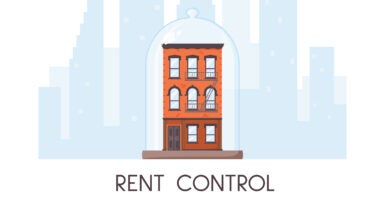For more than 50 years, New York City’s so-called rent stabilization law has been squatting on the books and causing trouble.
The 2nd U.S. Circuit Court of Appeals upheld the law despite property owners’ strong arguments that the mandate constituted both a per se physical taking and regulatory taking in violation of the Fifth Amendment. This month, the U.S. Supreme Court refused to hear an appeal this term.
For now, the egregious law stands.
It would have hardly been missed. The rent stabilization law represents a startling threat to private property rights. For more than 50 years, it has also failed to deliver on its supposed goal: more abundant affordable housing.
Median rents in Manhattan are now nearly $4,400 monthly. Permissible rent increases are set citywide each year by the Rent Guidelines Board, which must consider tenants’ ability to pay in addition to an increase in the owner’s costs.
By factoring in the ability to pay, the law goes far beyond a simple universal regulation of rent level that allows an owner to recover reasonable costs and a reasonable return on capital.
That’s why over the past 20 years, the permissible increase percentage has been just half of the owners’ increased cost percentage (based on the board’s own index of owner’s costs).
The rent stabilization law also allows tenants to renew the lease in perpetuity, allows tenants to transfer their leasing rights forever to others, and forces owners to either find tenants alternative rent-stabilized housing or compensate them—sometimes to the tune of more than $1 million per tenant.
As if that wasn’t enough, the rent stabilization law gives tenants veto power over an owner’s plans to vacate, redevelop, or segment the apartments into condos.
As defined by Black’s Law Dictionary, property rights encompass “the exclusive right of possession, enjoyment, and disposal; involving as an essential attribute the right to control, handle, and dispose.” The rent stabilization law erodes each of these vital aspects of private property ownership.
The plaintiffs seeking action by the Supreme Court argued the law also represents a frontal assault on the right to private property guaranteed by the “Takings Clause” of the Fifth Amendment of the United States Constitution: “No person … shall be deprived of … property without due process of law; nor shall private property be taken for public use without just compensation.”
Among the most troubling aspects of the rent stabilization law are provisions permitting a tenant to stay in a property after the lease expires into perpetuity and granting tenants the power to transfer a lease to third parties without the owner’s consent.
Rather than a mere regulation of private property, this legalizes permanent occupation of private property against the wishes of the owner—depriving the owner of the “right to exclude,” a right described by the Supreme Court as “one of the most treasured rights of property ownership.”
As the court continued in Cedar Point Nursery v. Hassid (2021): “Given the central importance to property ownership of the right to exclude, it comes as little surprise that the Court has long treated government-authorized physical invasions as takings requiring just compensation.”
Yet the 2nd U.S. Circuit Court of Appeals arbitrarily held that this recent Supreme Court decision does not apply to residential properties. The property owners reject the notion that the Constitution’s protections against government-authorized invasion and occupation of private property evaporate if an owner chooses to participate in the regulated rental housing market.
The rent stabilization law also goes far beyond typical rent control by basing maximum allowable rent increases in large part on tenants’ ability to pay. By factoring in ability to pay, the RSL bars owners from fully recovering their costs and requires them to subsidize rents—what the N.Y. Court of Appeals admitted is a “local public assistance benefit” paid for by a select group of property owners (In re Santiago-Monteverde, 2014).
Local governments wishing to provide rental housing relief should do so through transparent, democratically implemented assistance. This spreads the cost of aid across the public as a whole, rather than placing the entire burden on a small group of property owners.
Housing affordability is a very real problem. But truly expanding affordability requires confronting the roots of the problem; namely, policies that make it difficult if not impossible to build more housing.
On the local level, stringent zoning restrictions, density limitations, and aggressive environmental regulation limit the supply of housing while increasing the costs of construction. Regulations often account for more than 30% of the costs of rental housing construction.
Rent control further compounds the problem by deterring new construction, giving landlords fewer incentives to spend on upkeep and remodeling, and reducing the future supply of housing.
Egregious property taxes are a culprit as well. Nationwide, state and local property tax revenue skyrocketed by nearly 15% over the past three years. For a median-priced home in New Jersey or New York City, property taxes exceed $6,000 annually.
In addition, trillions of dollars of subsidized mortgages through government sponsored enterprises, combined with the Federal Reserve purchases of trillions of dollars of mortgage-backed securities, inflates real estate prices.
The rent stabilization law’s draconian regulations and outright allowance of physical occupation will not remedy this situation. It does, however, unjustly harm private property owners.
It’s easy to see why New York City should send it packing.
Have an opinion about this article? To sound off, please email [email protected] and we’ll consider publishing your edited remarks in our regular “We Hear You” feature. Remember to include the url or headline of the article plus your name and town and/or state.

























